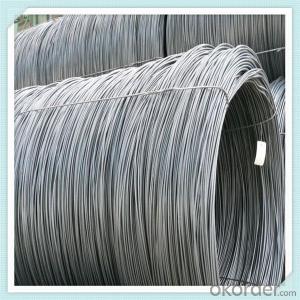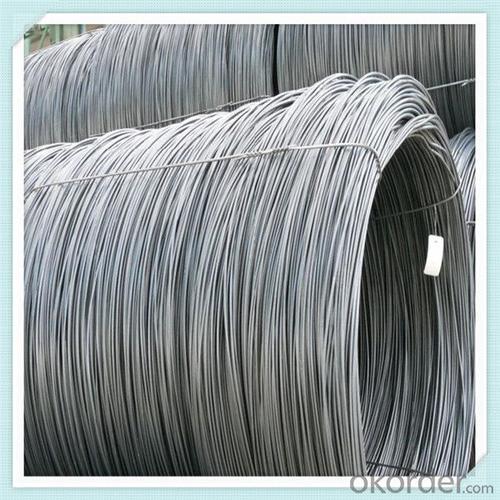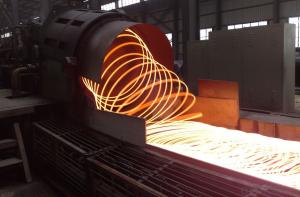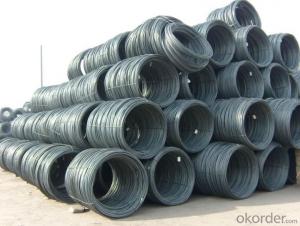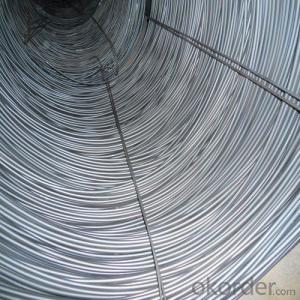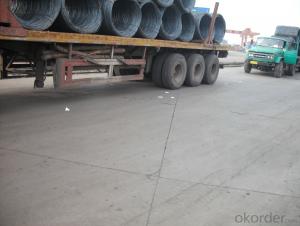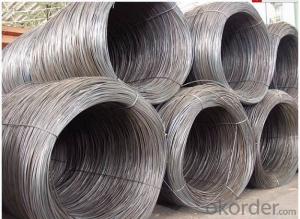SAE1008 Steel wire rod low carbon in good quality
- Loading Port:
- China main port
- Payment Terms:
- TT OR LC
- Min Order Qty:
- 100 m.t.
- Supply Capability:
- 18400 m.t./month
OKorder Service Pledge
OKorder Financial Service
You Might Also Like
Specification
Features
1、Pure steel quality, stable chemical contents, small tolerance.
2、Constant Quality, good drawing performance.
3、High dimension accuracy degree, accuracy degree of Level C up to 80%, smooth surface, less scale,
easy to be pickled.
4、Automatic bundling with 4 lines by Machine in tidy and good looks
5、Big high quality percentage, small coil percentage, and heavy coil weight for Hard Coil.
6、High sorbitizing percentage.
Steel wire is mainly used for prestressed and posttensioning technology in various shapes of prestressed
concrete structures,and widely used for civil engineering construction, such as large scale railroad, highway
bridges, building trusses, overhead crane beams, industrial and prefabricated concrete floor, wall board,
tubular piles, PC water pipes, TV towers and nuclear power station, ETC. Active strandards:GB/T5223,
ASTMA421, BS5896, JISG3536, ISO6934, EN10138 or other special required standards.
Product Description :
Standard | AISI, ASTM, BS, DIN, GB, JIS |
Material/steel grade | Q195-Q235,SAE1006B,SAE1006CR, SAE1008B, SAE1008CR, SAE1010B, SAE1018B, or according to customers requirements |
Wire Gauge | 5.5-12mm |
Coil weight | 1.8-2.1mts |
MOQ | 25MT |
Delivery Time | 15-30 days after receipt of L/C or deposit by T/T |
Packing | In coil and load in container, if large quantity, by bulk vessel; Can be packed as customers' special requirements |
Payment terms | 1).100% irrevocable L/C at sight. 2).30% T/T prepaid and the balance against the copy of B/L. 3).30% T/T prepaid and the balance against L/C |
Application | widely used in machinery parts, manufacturing industry, electronics industry, metal tools and others |

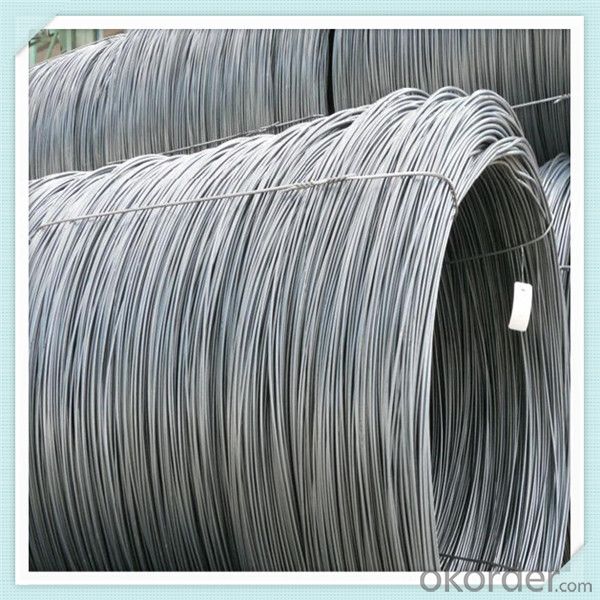
Application :
It generally used in braiding the hose for bathing product and machinery. With it
good flexibility, resistant to high temperature and resistant to corrosion, it
used widely in many industries.
Packing :
Hot-rolled wire rod is held in a unit with at least four steel straps in the
transverse direction and transported and stored without further packaging.
Before
the steel strapping is applied, the wire rod must be sufficiently compressed.
The strapping is fixed in the transverse direction with a single circumferential
strap so that the strapping does not slip and cause the coil to come apart.
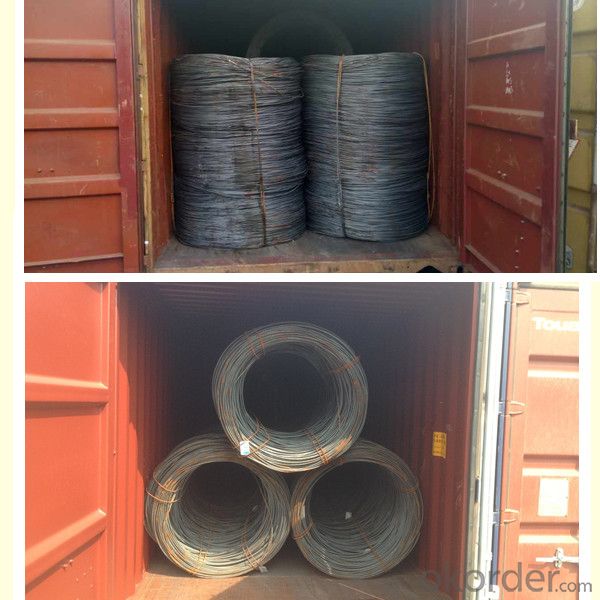
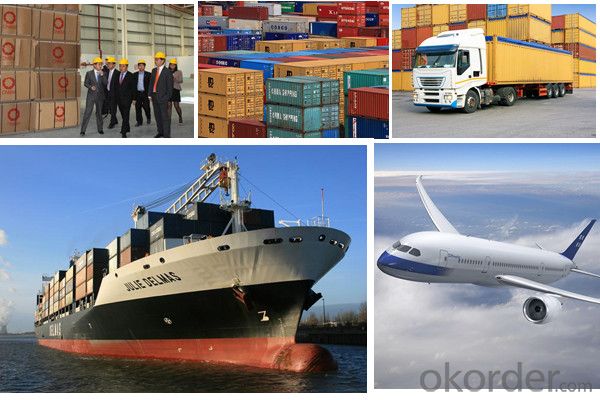
Our service:
(1) We cooperate with famous factories with advanced equipment and well trained workers.
(2) We can provide factory price with trading company service.
(3) We continuously work on the improvement of our processes, guaranteeing
consistently high standards of quality to keep none compensation.
(4) We guarantee 24 hours response and 48 hours solution providing service.
(5) We accept small order quantity before formal cooperation.
(6) We deliver the agreed quality at the agreed time, reacting to changes in
customer wishes in a flexible way.
(7) Due to our volume and selling power, we have excellent freight rates with
shipping lines.
(8) We strive to always be fair and honest in our dealings with customers.
(9) We strive to work together with customers to achieve much more than we can
achieve alone.
(10) Through our passion and commitment we aim to be a market leader in all our
key markets. To maintain our position as market leader we must continue to add
value in all that we do.
FAQ:
1.Q: What's your MOQ(minimum order quantity)?
A: One full container, mixed acceptable .
2. Q: What's your packing methods?
A: Packed in bundle or bulk ..
3. Q: How can I buy CNBM products in my country?
A:Please send us an inquiry or email ,we will reply to you if there is distributor in your country
4. Q: Can we visit your factory?
A: Warmly welcome. Once we have your schedule, we will arrange the
professional sales team to follow up your case.
5. Q: How long does it take to get the product if i place an order?
A:With the process of your requirements,we will pack and deliver in 3
-7 days. If it is by sea shipment,it will take 15-45 days depending on different locations
- Q: How is steel wire rod used in the manufacturing of cold heading quality wire?
- Steel wire rod is a crucial raw material used in the manufacturing of cold heading quality wire. Cold heading quality wire is a type of wire that is specifically designed to be used in cold heading processes, where the wire is shaped into various fasteners such as bolts, screws, and rivets. To manufacture cold heading quality wire, steel wire rod undergoes several processes. First, the steel wire rod is carefully selected based on its chemical composition and mechanical properties, ensuring it meets the required standards for cold heading applications. The rod is typically made of low carbon steel, which offers excellent formability and strength. Once the appropriate steel wire rod is selected, it is then heated to a specific temperature and rolled into a smaller diameter. This process is known as hot rolling, and it helps to improve the wire rod's mechanical properties and surface finish. The hot-rolled wire rod is then cooled and straightened to remove any residual stress and achieve the desired shape and size. After hot rolling, the steel wire rod is further processed through a series of cold working operations. This includes drawing the wire rod through a series of dies to reduce its diameter and improve its surface smoothness. The wire is then annealed to restore its ductility and relieve any internal stresses caused by cold working. Finally, the cold heading quality wire is coated with a lubricant to enhance its formability and reduce friction during the cold heading process. The lubricant helps the wire to flow smoothly through the cold heading machinery, allowing it to be shaped into the desired fastener shape without any cracks or defects. In summary, steel wire rod is a fundamental material used in the manufacturing of cold heading quality wire. It undergoes a series of hot rolling, cold working, and coating processes to transform it into a wire that is suitable for cold heading operations. This ensures that the wire possesses the necessary mechanical properties, surface finish, and formability required for the production of high-quality fasteners.
- Q: How is the wear resistance of steel wire rod assessed?
- Assessing the wear resistance of steel wire rod can be done using various methods. One commonly used approach involves conducting the pin-on-disk test. In this test, a steel pin is pressed against a rotating disk made of a different material. The amount of wear experienced by the steel pin is then determined by measuring the weight loss or volume loss after a certain number of rotations. Another method, known as the abrasion test, entails rubbing the steel wire rod against a rough surface and measuring the resulting wear. Furthermore, evaluating the wear resistance of the steel wire rod can also be achieved by subjecting it to realistic conditions, such as within a machine or equipment, and observing its performance over time. These methods serve to gauge the steel wire rod's ability to endure wear and offer invaluable insights for the development and enhancement of products.
- Q: What are the different types of steel wire rod coatings used for abrasion resistance?
- There are several types of steel wire rod coatings used for abrasion resistance, including zinc coatings, epoxy coatings, polyurethane coatings, and ceramic coatings. These coatings help to protect the steel wire rod from wear, friction, and other forms of abrasive damage, thereby increasing its durability and lifespan.
- Q: How is a steel wire rod manufactured?
- The production of a steel wire rod in a steel mill involves several steps. To start, impurities are removed and molten iron is created by melting iron ore in a blast furnace. This molten iron is then refined in a basic oxygen furnace (BOF) or an electric arc furnace (EAF). In the BOF or EAF, the molten iron is mixed with scrap steel and other alloying elements to achieve the desired composition and quality. This mixture undergoes high temperatures and chemical reactions, which help eliminate impurities and adjust the carbon content. Once the desired composition is achieved, the molten steel is cast into billets or blooms using continuous casting. These billets or blooms solidify into a semi-finished product, which is reheated to a rolling temperature. The reheated billet or bloom is then passed through a series of rolling mills. Initially, it goes through a roughing mill that reduces its size and shape. It then proceeds to a series of intermediate and finishing mills, which gradually decrease the cross-sectional area and refine the shape further. During the rolling process, the steel undergoes high pressure, elongating it and reducing its diameter. This continuous elongation and reduction in size enhance the strength and ductility of the wire rod. After the final rolling pass, the wire rod is cooled and wound onto a spool. It then undergoes various surface treatments, such as pickling or coating, to eliminate any mill scale or oxidation and enhance the surface quality. Finally, the wire rod is tested for its mechanical properties, dimensions, and surface quality. It is either shipped as a finished product to customers or further processed into different steel wire products, such as wires for construction, automotive, or industrial applications. In summary, the production of a steel wire rod involves a combination of melting, refining, casting, rolling, and surface treatment processes to manufacture a high-quality product with the desired properties.
- Q: What are the main factors influencing the choice of steel wire rod dimensions?
- The main factors influencing the choice of steel wire rod dimensions include the intended application, desired mechanical properties, manufacturing capabilities, cost considerations, and industry standards or specifications.
- Q: What are the different types of wire mesh for filtration made from steel wire rod?
- There are several types of wire mesh for filtration made from steel wire rod, including woven wire mesh, welded wire mesh, and expanded metal mesh. Each type has its own unique characteristics and applications in filtration systems.
- Q: What are the different types of steel wire rod surface defects and their prevention methods?
- During the manufacturing process, various defects may arise on the surface of steel wire rods. These defects encompass scratches, pits, scale, cracks, and surface irregularities. The presence of any of these defects can adversely impact the quality and performance of the wire rods. Therefore, understanding the causes and employing prevention methods is crucial. 1. Scratches: Improper handling or contact with abrasive materials can lead to scratches. To prevent this, it is essential to handle the wire rods delicately and avoid contact with rough surfaces. The use of protective coverings or pads during transportation and storage can also serve as a preventive measure against scratches. 2. Pits: Pits refer to small depressions or cavities on the surface of the wire rods. They can occur due to impurities in the raw materials or the manufacturing process itself. To prevent pits, it is imperative to utilize high-quality raw materials and maintain proper cleaning and maintenance of the manufacturing equipment. 3. Scale: Scale refers to the oxide layer that forms on the wire rod surface during manufacturing, resulting in a rough and uneven surface. To prevent scale formation, it is important to control the temperature and atmosphere during the manufacturing process. Regular cleaning and maintenance of the equipment also aid in preventing scale. 4. Cracks: Excessive stress or improper cooling during manufacturing can lead to cracks. To prevent cracks, it is crucial to regulate the cooling rate and ensure proper heat treatment of the wire rods. Using appropriate lubrication during wire drawing can also reduce stress and prevent cracks. 5. Surface irregularities: Surface irregularities include bumps, dents, or unevenness on the wire rod surface. These irregularities can arise due to mishandling or issues with the manufacturing equipment. To prevent such irregularities, one must handle the wire rods with care and maintain and calibrate the manufacturing equipment properly. In conclusion, the manufacturing process of steel wire rods can give rise to several surface defects. To prevent these defects, careful handling of the wire rods, utilization of high-quality raw materials, regular maintenance and cleaning of the manufacturing equipment, control of temperature and atmosphere, and proper heat treatment and lubrication are essential. Implementing these prevention methods can greatly enhance the quality and performance of the steel wire rods.
- Q: What are the factors affecting the price of steel wire rod?
- There are several factors that can affect the price of steel wire rod, including the cost of raw materials such as iron ore and coal, supply and demand dynamics in the steel market, fluctuations in currency exchange rates, and government policies and regulations. Additionally, factors like production costs, transportation expenses, and the overall economic conditions can also have an impact on the price of steel wire rod.
- Q: How is the chemical composition of steel wire rod analyzed?
- The chemical composition of steel wire rod is typically analyzed using various laboratory techniques such as spectroscopy, X-ray fluorescence (XRF), and optical emission spectroscopy (OES). These methods involve exposing the wire rod to high energy sources or chemical reactions to determine the presence and concentration of different elements in the steel. By analyzing the chemical composition, manufacturers can ensure that the steel wire rod meets the required standards and specifications for its intended applications.
- Q: How are steel wire rods used in the production of wire hangers for hanging clothes?
- Wire hangers for hanging clothes require steel wire rods as a vital component. These rods are typically made from high-quality, durable steel, which provides the necessary strength and rigidity to support the weight of garments. To create the hangers, the first step in the production process involves cutting the steel wire rods to the desired length. This can be done using specialized machinery or manual cutting methods. Once cut, the rods are then bent into the familiar hanger shape, usually with a combination of automated bending machines and skilled workers. The steel wire rods are shaped to form the top hook of the hanger, allowing it to be hung on a closet rod or other hanging mechanisms. Additionally, the rods are bent to create the curved body of the hanger, which provides a secure and stable structure for hanging clothes. After the basic shape of the hanger is formed, the steel wire rods may undergo further processes to enhance their functionality and appearance. This could involve coating the rods with a layer of protective material, such as plastic or vinyl, to prevent rusting and create a smooth surface for delicate fabrics. The hangers can also be painted or coated with various colors or finishes to match different branding or aesthetic preferences. In conclusion, steel wire rods are indispensable in the production of wire hangers for hanging clothes. Their strength, durability, and versatility make them an ideal material for creating hangers capable of supporting a wide range of garments. Whether in homes, retail stores, or laundry facilities, wire hangers made from steel wire rods are a staple tool for organizing and displaying clothes.
Send your message to us
SAE1008 Steel wire rod low carbon in good quality
- Loading Port:
- China main port
- Payment Terms:
- TT OR LC
- Min Order Qty:
- 100 m.t.
- Supply Capability:
- 18400 m.t./month
OKorder Service Pledge
OKorder Financial Service
Similar products
Hot products
Hot Searches
Related keywords
